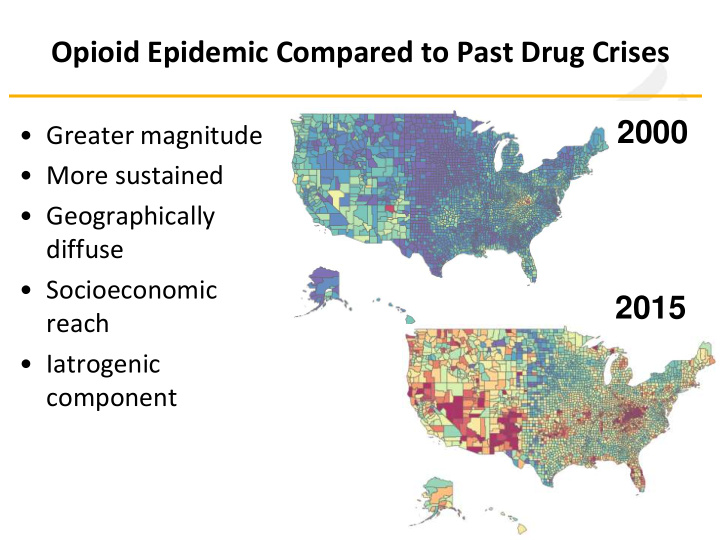



Opioid Epidemic Compared to Past Drug Crises 2000 • Greater magnitude • More sustained • Geographically diffuse • Socioeconomic 2015 reach • Iatrogenic component
Source: CDC NCHS and Samkoff and Baker, AJPH 1982. Deaths per 100,000 population 10 12 14 16 18 0 2 4 6 8 1970 1971 1972 1973 Sustained Impact of the Opioid Crisis 1974 Heroin 1975 1976 1977 1978 1980 1981 1982 1983 Drug Overdoses 1984 1985 1986 1987 Cocaine 1988 1989 1990 1991 Opioid-Involved Overdoses 1992 1993 1994 1995 1996 1997 1998 1999 2000 2001 2002 2003 2004 Opioids 2005 2006 2007 2008 2009 2010 2011 2012 2013 2014 2015
Epidemic Continues to Evolve Drug Overdoses Synthetic Opioids Heroin Natural/Semi-Synthic Opioids Methadone Cocaine Psychostimulants 70,000 25,000 60,000 Number of Deaths Involving Select Drug Categories 20,000 Number of Drug Overdose Deaths 50,000 15,000 40,000 30,000 10,000 20,000 5,000 10,000 0 0 Jan Feb Mar Apr May Jun Jul Aug Sep Oct Nov Dec Jan Feb Mar Apr May Jun Jul Aug Sep Oct Nov Dec Jan Feb 15 15 15 15 15 15 15 15 15 15 15 15 16 16 16 16 16 16 16 16 16 16 16 16 17 17 Source: CDC NHCS
Impacted Populations and Health Consequences Continue to Expand HIV HCV
Origins of the Epidemic and a Path to Solutions Increases in opioid-related harms fundamentally tied to two primary issues • Significant rise in opioid prescribing that began in the mid-to-late 1990s – Prescribing opioids for different types of chronic pain conditions that we now know do not often benefit from opioids in the long-term – Prescribing higher doses and for longer durations – Prescribing opioids in combination with medications like benzodiazepines which can substantially increase risk for overdose • Lack of health system and provider capacity to identify, engage, and provide high-quality, evidence-based opioid addiction treatment, in particular mediation- assisted treatment with naltrexone, buprenorphine, or methadone – Majority of people with opioid addiction in the U.S. do not receive treatment – Even among those who do get treatment, many do not receive evidence-based care – Lack of access to and provision of treatment is a significant contributor to rising rates of heroin and fentanyl use, rates of injection drug use, and overdose death
Recommend
More recommend